Paco Rabanne Retro Futurism Fashion

Paco Rabanne is one of the most notable 1960s fashion designer in terms of retro futurism fashion. Unlike contemporaries, Pierre Cardin and André Courrèges who designed futuristic fashion with new materials and modern technology, Paco Rabanne's chainmail dresses reference an earlier time, a retro futurism aesthetic reminiscent of Fritz Lang's Metropolis in the 1920s.
Paco Rabanne has been the main inspiration for our metallic 'modern chain mail' apparel and chainmail purses. This blog is our homage to Paco.

On July 20 1969, the entire world watched entranced as images of the Apollo 11 moon landing were beamed from outer space back to black & white TV screens. Futuristic fantasy seeped into pop culture as a bi-product of the space race. 1960s kids consumed campy sci-fi TV shows and adults watched Kubrick, and as the 60s moved into the 70s the obsession continued with the futuristic fashion of Ziggy Stardust glam rock and the Afro Futurism of Funkadelic and Sun Ra.
Fashion designers of the 1960s were also influenced with a futuristic aesthetic and this was especially the case in France.

Paco Rabanne made his debut onto the French fashion scene in 1966 with a collection entitled: "12 Unwearable Dresses in Contemporary Materials". He was eccentric, eager to experiment and sufficiently confident in his abilities to deliberately provoke the French fashion establishment. The commotion around the launch of the collection established Paco as the enfant terrible of 60s French fashion.
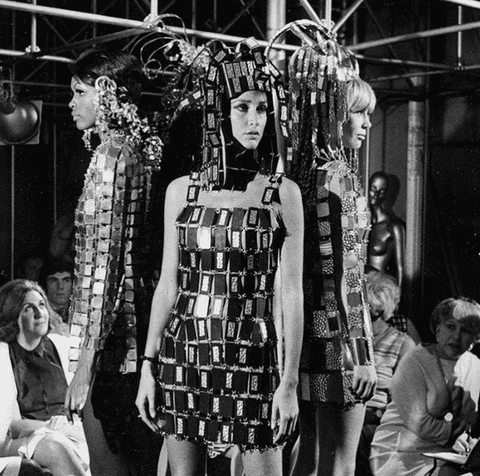
12 Unwearable Dresses in Contemporary Materials, 1966
The "Unwearables" collection of metal dresses used geometric plates stamped from brass, rhodoïd plastics, and sequins held together with steel jump rings. Using pliers and rings as opposed to needle in thread, the dresses were like medieval chainmail adapted and reintroduced as futuristic outfits. “I defy anyone to design a hat, coat or dress that hasn't been done before...The only new frontier left in fashion is the finding of new materials.” Paco Rabanne was dismissed by many in the French fashion establishment, including Coco Chanel who quipped, "He's not a couturier, he's a metal worker". In fact Paco Rabanne was a metal worker. After studying architecture at Les Beaux-Arts in Paris, the young fashion designer got his start designing jewelry for fashion houses including Dior, Givenchy, and Balenciaga. But as anyone who has ever worn or owned a Paco Rabanne chainmail dress will tell you, the dresses are incredible and they fit beautifully.
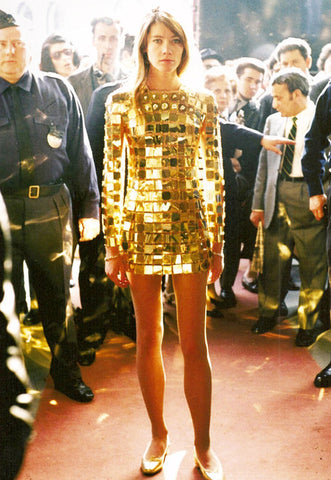
Yé-yé girl, Françoise Hardy in Futuristic Metal Dress
While Rabanne had many detractors in the 60's French fashion world, his futuristic style found fans among the young club kids and social influencers of the day known as the yé-yé girls. Translated directly from English 'yeah yeah', the yé-yé girls were young French singers and actresses that were swept up in the music and cultural trends of British-mods and American rock & roll. Brigitte Bardot and Françoise Hardy were among Paco Rabanne's biggest fans. Rabanne's radiant glamorous space-age gowns helped propel some of these young women to stardom and they in turn helped create indelible images that make him remembered as one of the most iconic designers of this period.
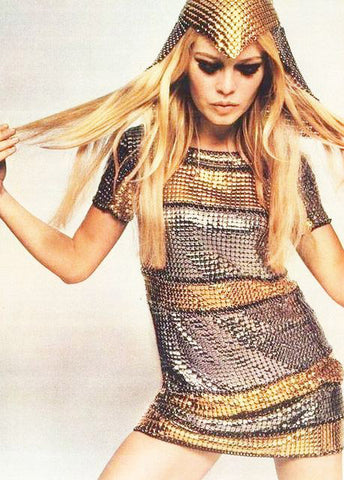
Brigitte Bardot in Paco Rabanne Chain Mail Mini Dress
Rabanne continued to experiment with unusual materials including neon leather, aluminum, chainmail, rubber, plastic sheeting and paper. The most well known design is the metallic mini dress which was popularized by Jane Fonda, Françoise Hardy and Jane Birkin and was followed by soft paper dresses in (1967), beaten metal aluminum jersey (1968), dresses made out of linked buttons (1970), ostrich feathers attached with Velcro (1972). Rabanne's work is heavily influenced by the Surrealist and Dada movements and it's not surprising that he was close friends with fellow Spaniard, Salvador Dalí.
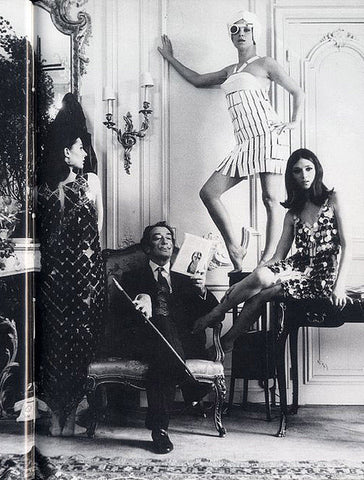
Throughout the 60s Paco Rabanne was in-demand to create dramatic outfits for celebrities including Elizabeth Taylor and Audrey Hepburn. The 1968 film, Barbarella starring Jane Fonda was the perfect vehicle to showcase the futuristic costume design and scene after scene highlighted different outfits made of chain mail, molded plastic and feathers. Rabanne's retro futurism aesthetic was right at home in the campy sci-fi film that endures as a cult classic.

Jane Fonda as Barbarella, Paramount 1968
His success was not only limited to clothing and costume design, in 1969 he had a smash hit with the metallic 'It' bag, a simple square envelope with a shoulder strap. It was made from his signature coin sized plated discs linked with steel jump rings and finished with a metal link chain strap made from a repurposed metal toilet chain. His choice of a toilet chain was a deliberate swipe at Coco Chanel who continued to refer to him with the nickname, "the metal" and who at the time was working on a purse with a chain strap. This iconic purse has been the source of inspiration for our own metallic purses.
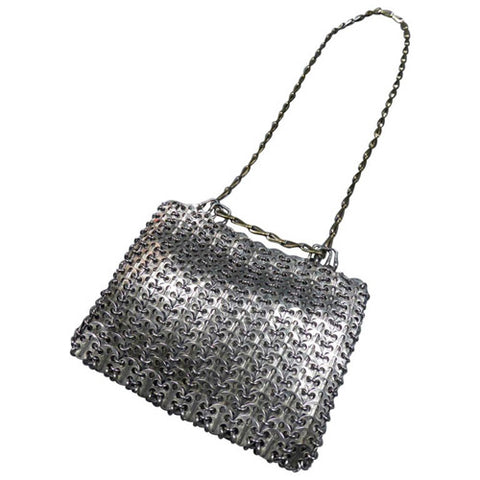
The 'It' Bag with Repurposed Toilet Chain Strap
Paco Rabanne was not the only French designer inspired by futuristic themes. On this 50th anniversary of the lunar landing, the Brooklyn Museum will launch the show entitled Pierre Cardin: Future Fashion.
It's odd to consider how the obsession with outer space was very much of that era and then vanished. In the past we thought about the future -- what clothes would we wear in outer space? how would we live in outer space? Now 50 years on, the reality of space travel for private citizens is literally only a question of money. And yet ironically it no longer captures our imagination. No one seems to be that interested in outer space at all.
For more stories, see our interview with Paco Rabanne model, Sandi Collins).


My mother is the model on the far left side in the second and third photos. Thank you so much for sharing the amazing work they accomplished!!!
Leave a comment